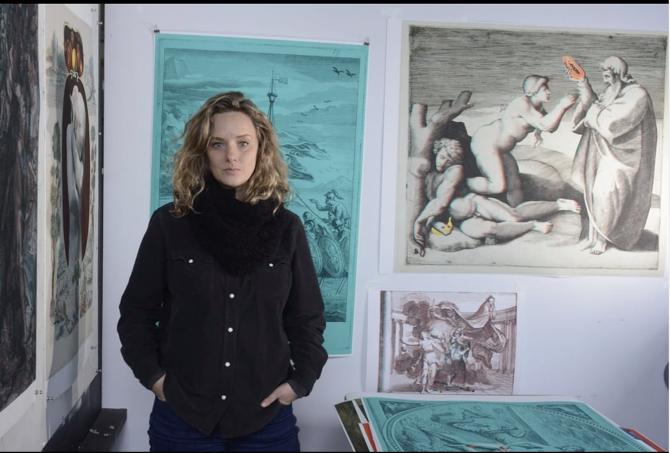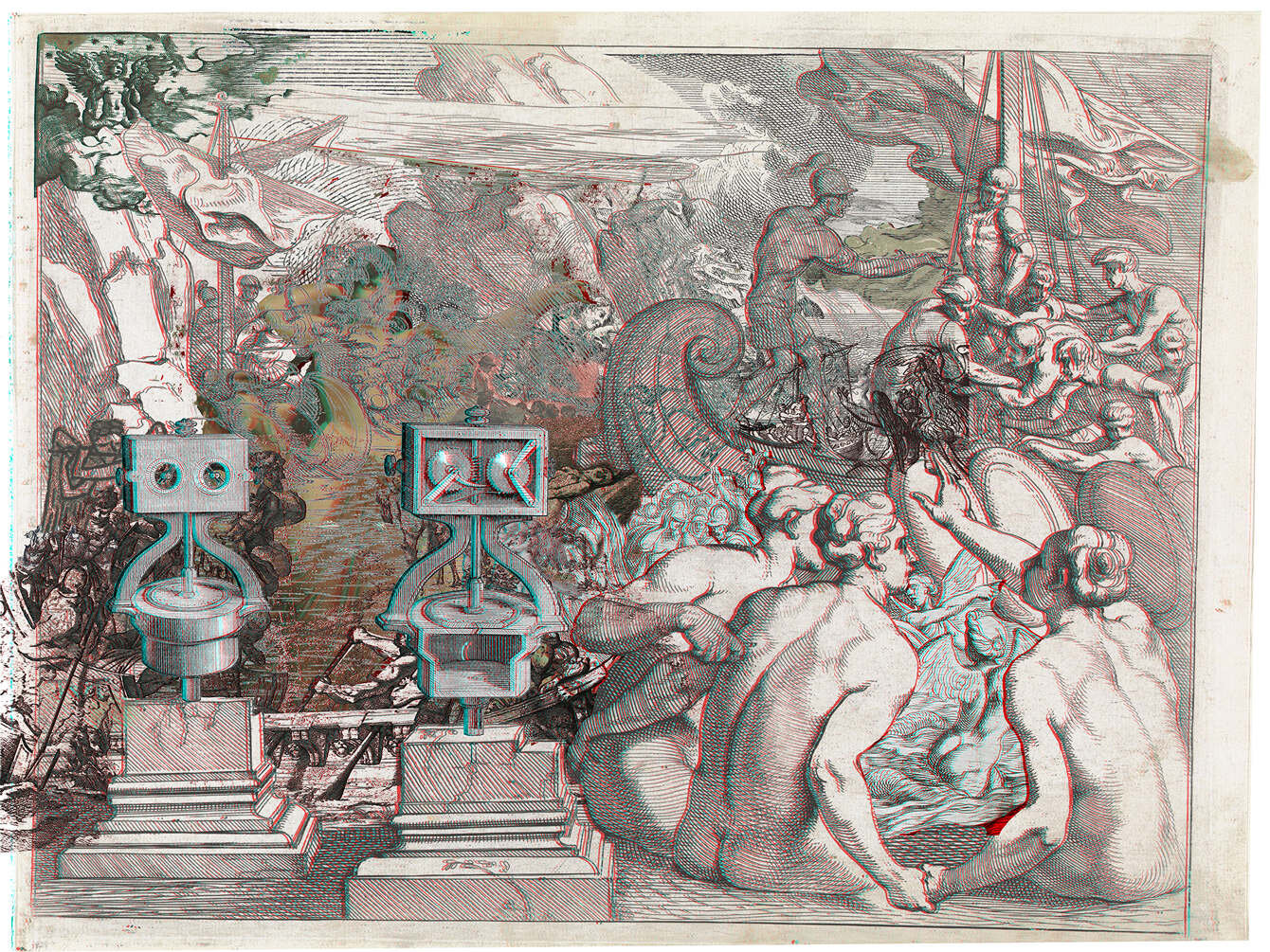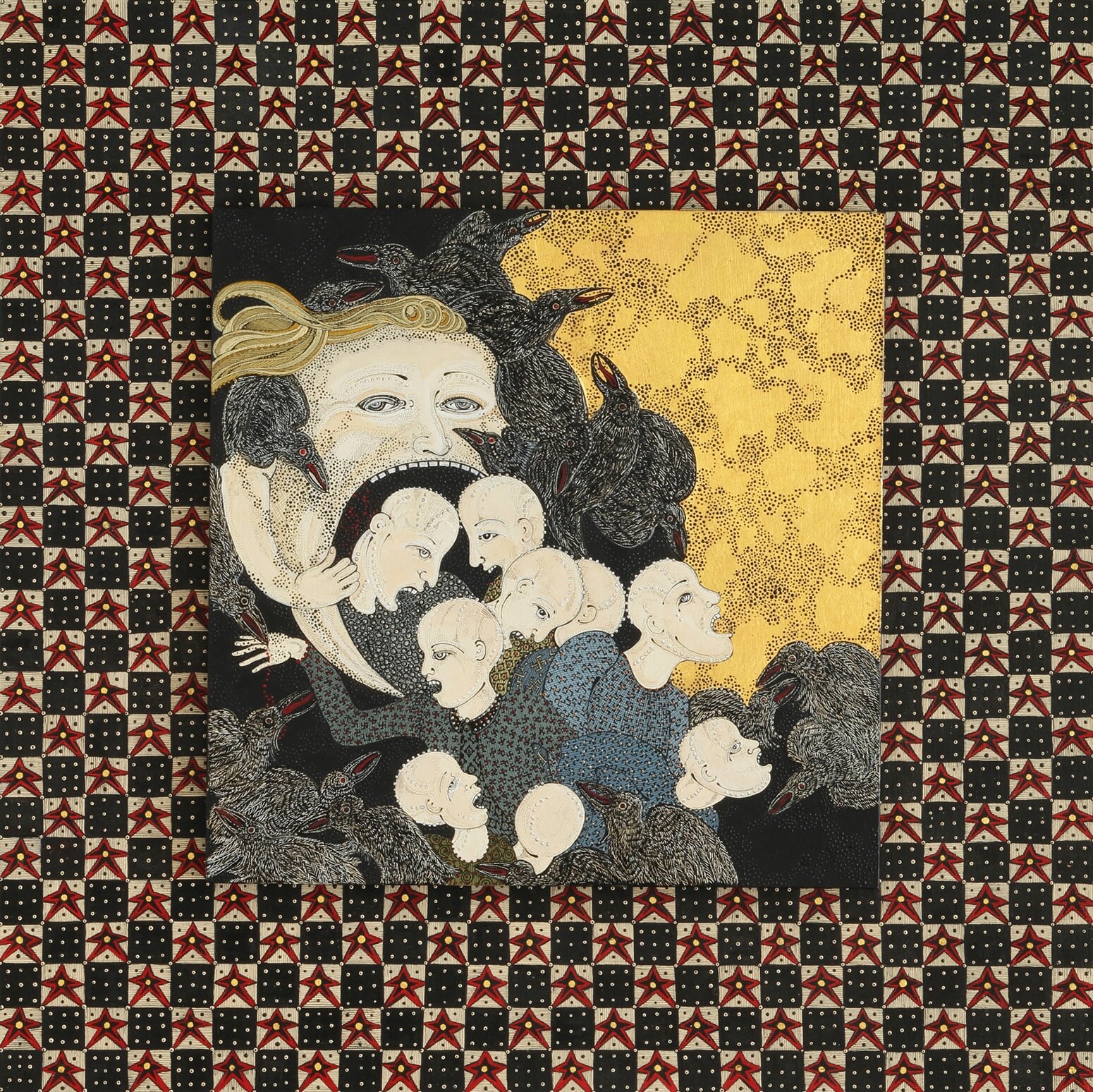Women Artists of the Pacific Northwest
Skip to: Stephanie Wilde, Natalie Ball
The artist Whitney Lynn (Photo by Rel Robinson)
Whitney Lynn
Seattle, Washington
In her 2018 translation of Homer’s Odyssey, Emily Wilson makes a point of altering (or correcting) the standard English translation of one of the epic’s most famous scenes: Odysseus’s encounter with the Sirens. Wilson’s change is simple: she swaps the word “lips” for “mouth,” which she argues is a more accurate translation of the Greek. In this shift, Wilson reorients the Sirens’ threat from their ability to seduce with “honeyed lips” to the sweet allure of not their bodies, but their wisdom, which the mouth is instrumental in communicating.
Theme and Variations (2019)
The mistranslation and manipulation of the mythical Siren from terrifying truth teller to sexy mermaid is one that has fascinated Seattle artist Whitney Lynn. A project-based artist, Lynn does not silently accept the images and objects that have become a part of our culture, but rather centers her practice on investigating their origins, insisting there are always other ways of seeing the images we find in front of us.
In the case of the Sirens, she understands their value lies not in what they are today, nor what they were at their inception, but rather how (and why) they made the transition between these points. This leap is literalized in tapestry works based on Lynn’s drawings, which the artist commissioned from a jacquard weaving studio in North Carolina. Though Lynn often works with professional fabricators, who make everything from neon to leather goods to her specifications, their engagement with her instructions was of particular importance for this project, as “whatever it turned out like I was going to be okay with,” the artist says; after all, “it was about that.” The Siren became what it is today as the story passed from person to person, generation to generation. The results of the weavers’ interpretation, therefore, were purposefully out of the artist’s hands.
Song of the Siren (2019)
Lynn allows others to take part in the meaning of her work in other projects as well, as in the series Forbidden Illusions. In order to see the layered images in these works, which are otherwise invisible to the naked eye, Lynn asked her audience to wear 3-D glasses. In this grouping of works two scenes—one innocent, one not so much—are combined in a single overlaid image. Though they exist simultaneously, the more explicit one— a scene of violence or eroticism— is obscured until the glasses are donned. Unwittingly complicit, the viewer must confront her role in observing this illicitness, or else take the glasses off and look away, knowing full well what they’ve chosen to ignore (and thus, passively condone).
Nothing in Lynn’s oeuvre is as it seems, and this can allow her to get away with what might be deemed unacceptable if rendered in more direct terms, symbolism acting as the proverbial spoonful of sugar, rendering the art more palatable to a wide audience (at least at first glance). This technique is particularly useful when employed in her commissions of public art. For her piece at the San Diego airport, for example, what appears to be a gorgeous explosion of flowers affixed to a plate glass window is, at closer inspection, a blatantly political statement. Like the bouquets of Dutch still lives, each of these flowers has a meaning. In this case, their meaning is derived from their place of origin: the seven countries listed in Trump’s 2017 travel ban. An exuberant display of welcome, this window mural makes a statement about acceptance and the beauty of a diverse America in terms that center on joy, not politics.
Installation at the San Diego Airport, Not Seeing is a Flower (2018)
The Siren reappears for Lynn’s latest art project on Seattle’s waterfront, titled the Silence of the Sirens, whose date of unveiling is to be determined. Though the project is still in progress, when it is installed my advice to the people of Seattle is this: when it comes to Whitney Lynn, what you see is not what you get. Look twice and you will be rewarded.
More on Whitney here.
STephanie Wilde
Boise, Idaho
The painter Stephanie Wilde believes art is “instinctual,” and an art degree may or may not mean you’ve got what it takes. It might not surprise you, then, to hear that Wilde herself has no art degree of which to speak, though these convictions are by no means self-congratulatory.
Fear (2004)
Ink and acrylic on museum board
12” x 12”
They stem from tragedy, having witnessed the loss of a generation of artists during the AIDS epidemic of the 1980s. These artists were drawn to art out of a vital need to find a voice for the dying (as in the angry chaos of David Wojnarowicz’s work), something academia cannot not teach. “What gives you the luxury,” Wilde asks, to be an artist when so many great ones have died? In other words, anyone practicing art must have a deliberate intention in doing so.
Words (2018)
Ink, acrylic and gold leaf
13” x 13”
Wilde, it turns out, does have intention. In addition to a gut wrenching series centering on the loss of life to AIDS, she has proven remarkably adept at prophesying through her intricately detailed paintings—not because of any supernatural connection with the divine, but rather due to a combination of a keen sense of human nature as well as a bit of physical distance from the action, which gives her the perfect vantage on current events.
The artist has developed a methodology over the past thirty-eight years living in Boise, Idaho, which tries to answer the question, “Who am I in this culture?” And while at times it can be more difficult to find the artistic communion so easy to come by in a place like New York or Los Angeles (something which I am sure we coastals take for granted) she has no doubt that this isolation has shaped her work—and only increasingly in a world populated by so much noise—much of it frustrating and ignorant (“ill-informed has a voice these days,” the artist says).
Wilde says she feels protected in Idaho, free from distraction—this lets her work find its message in organic ways, which seem to grow, mature, and exhaust themselves in cycles of seven years—the same amount of time the body takes to regenerate its cells.
Will They Chop Down the Clouds (2018)
Ink, acrylic and gold leaf
22” x 22”
This biological parallel feels right to the artist, whose intuitions operate on such a deep level that they can feel at times to be unconscious. “I want [my audience] to peel the onion,” she says, to get more from the work than what can be gleaned from a quick glance.
Sacred Bees (2008)
Ink, acrylic and gold leaf
10” x 52”
At first look, Wilde’s work is beautiful. Painstakingly executed in rich blues and reds and accented in gold-leaf, her paintings are visually stunning. Their ornament, patterning, and rich flora are recognizable across her oeuvre, captivating in their precision, yet far from simply decoration.
The artist’s insistence on the importance of layers is literalized in its support: she delineates space physically in her work, placing one panel atop another, offsetting the central allegorical image from its frame. The content of the work, however, does not abide by the confines of this frame, but rather exists across both planes. This often creates the sensation of spillage or overgrowth—like a party bursting from a bar into the street, or a party crasher edging his way inside, the ornament demands to be noticed.
In one series, Wilde focuses her brush on bees, which initially appear as a decorative addition. Their inclusion at the edges, however, might be precisely the point. The decline of the honeybee was ignored, after all, because these insects exist at the periphery, as background hum to the action of life. It took us a while to understand they are, in fact, a direct reflection of that life, a bellwether of the planet’s health.
By painting the bee as both subject and beauty, the artist slyly proves her point—we are wont to ignore precisely what is most important to notice. That these works were begun in 2008, long before “save the bees” t-shirts and bee murdering hornets were a subject of interest, again proves Wilde’s prescience.
But perhaps this was always Wilde’s intention: her subject ensnares. Captivating by gold’s glint, we are helpless to look away. And therein lies one more advantage of living far from the noise of New York and LA: you learn to command attention.
More on Stephanie here.
Natalie Ball
Chiloquin, Oregon
The artist Natalie Ball
When I asked Natalie Ball where she sourced the material in her monumental assemblage sculptures, the list was long: “I find it, I trade for it... Ebay. Boutiques. Home Depot. Everywhere really. A lot of it comes from just my home.”
Ball, who is half Black and half Native, is a citizen of the Klamath tribes, on whose ancestral land she currently lives with her children. I, myself a collector of things, was particularly interested in those objects that were in her home there—the “moccasins and shovels” that were not sought out, but rather passed into the artist’s possession from sources unidentified. The stuff that’s just around and therefore has “already lived a life.”
It turns out that in the context of Ball’s practice, the elements that are passed down are not limited to physical things, but also include traditions, techniques, and even DNA. Among those techniques is the star quilt, a craft tradition originating with the Lakota people, which appears across Ball’s oeuvre. To receive a star quilt is a great honor, one that is traditionally granted after a significant achievement. The quilt is made by the women of the tribe and is meant to be given away.
Ball learned the traditional method for star quilting from Eileen, who is Sioux, “who taught Aunty Peggy...the old school way [with] poles to hold the quilt taut.” A nod to the quilt’s making can be seen in her work Re-Run (2019), in which the quilt hangs from its stretchers. By keeping the quilt’s construction armature within the piece, Ball seems to acknowledge this debt to her family.
Though these traditions are visible in her work, Ball insists “I don’t know how to talk about my work in that [craft] lens,” an assertion I find unsurprising, as craft can sometimes feel like second nature to us (which perhaps accounts for its downplay in our society). Craft is like DNA, passed down in similar ways. Can you explain the color of your eyes anymore than saying they’re the same color as your father’s? Sometimes we don’t need to ask why—it’s just how it is. “This is what I have,” Ball states. These techniques are one more element of her work, used just as if they could be laid alongside the jerseys, bones, and wigs which she uses as material.
Bang Bang (2019). Images my own.
When material and subject matter are predetermined, the project then becomes about how to use that material to make meaning. “We’re all trying to say something,” Ball insists, “The faster you can say it, the more clear you can say it, the better.” Double meaning works in Ball’s favor, and she is attuned to the symbols which have significance for both the Native and Black parts of her identity. Hair is one such thing, something which appears often in her work in the form of wigs. “I love having big hair,” she says, as it is in direct defiance of the straight long braids that make up the uninformed’s stereotypical image of “Indianness.”
Bang Bang (detail)
This is not to say that there isn’t any prejudice against big hair (and the genetics from which it results) in the Indigenous community itself—Ball walked me through the complex politics of being of mixed race while living on her ancestral land. In fact, it's one of her biggest qualms with the Native art scene: in an effort to preserve itself, the community has adopted strict rules for who is and is not considered part of the tribe. (These rules, called “blood quantum” are derived from laws instituted by the U.S. government to determine who was and was not eligible for citizenship.) Many of her works which directly engage with this (such as the 2018 work, “Putter,” which combines Nike Air Maxes with sinew and horse hair) have been met with skepticism and hostility from some of her fellow Indigenous artists. “I’m raising children,” Ball says in response to these rules, “We’re from here, but we’re from other places. To claim other things doesn't compromise our Indigeneity.”
Ball remains committed to her practice, however, an advocate for “pushing” Native art into a non-siloed space. “I want to be next to [the] Basquiats,” she insists, not in the othering Native spaces that museums install, which feel like attempts at appeasement, rather than advancement. (Museums, take note—Basquiat, himself of mixed cultural heritage using a cultural vernacular to explore American identity, would look superb next to Ball!)
Bundle (2019). Image my own.
As much as Native culture is about preserving, this preservation stems from its opposite—loss—and all that the United States has taken from its Indigenous people. In particular, Ball and I spoke of the head of her ancestor Kintpuash, or “Captain Jack,” who fought against the U.S. in the nineteenth century Modoc War, at the end of which he was hanged. His head then “circulated. It became part of museum collections… the Smithsonian housed it. We just got it back twenty years ago,” Ball tells me.
Don’t look so shocked—countless museums still have human remains in their collections. In fact, Ball has sent away to the Phoebe Hearst Museum at UC Berkeley for the remains of her ancestors, lamenting, “they have so many of our people, our bones.” (See for yourself—although most images are unavailable, whether to protect the squeamish or to shield the guilty remains unclear.) She hopes to use the contents of the returned box as material.
Re-Run (2019) at the Seattle Art Museum
Before you cringe at the idea of human bones entering the famously profiteering contemporary art market, know that Ball sometimes displays work with objects—for example, the hawk claw in her jaw dropping portrait of American contradiction Bang Bang (2019)—that she removes and keeps for herself if they are to be sold.
There is an enormous chasm between the symbolism of the star quilt, meant to be given away, and the bones of Ball’s ancestors, stolen and stored in archival boxes in the bowels of a museum. The two, however, meet in Natalie Ball’s work, opposing forces that coexist. By including elements of exploitation as well as preservation, she reminds us that the opposite of to give is not to take, but rather to receive.
In describing a visit to one such museum basement, Ball tells me about being accompanied by a museum employee to view baskets woven by her ancestors. “You have my things,” she says, “but you still control how I interact with my things.” To me this is the crux of Ball’s work—as an artist, she can put an end to this hegemonic control. She gets to decide when to do the giving, when to do the receiving , and above all, when to do the taking.
More on Natalie here.













